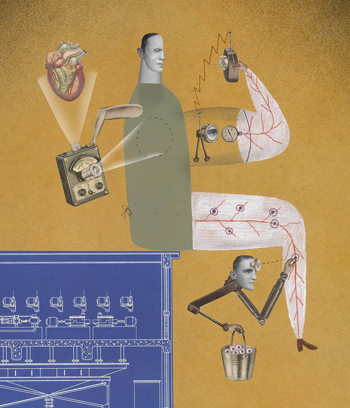A pantheon of medical device inventors reveals the best of the past, present and future
David Plunkert |
|
 |
|
By AMY ADAMS
Just about any encounter with the medical profession involves a medical device of some sort, but some of those tools are better than others. According to five leading inventors, one sign of an instrument’s greatness is its widespread use. A fabulous device that alleviates a rare condition might be a stroke of genius but these inventors wouldn’t necessarily put it on their medical-device MVP lists. “To me, something is great when it affects a lot of people, not when it solves a big problem,” says Julio Palmaz, one of the five world-renowned medical inventors who’ve weighed in for Stanford Medicine on the best medical devices of all time and the most wondrous ones to come.
Tom Fogarty, MD, pioneering vascular surgeon, invented the original balloon catheter, used to remove blood clots from veins. This invention started a new era of less-invasive procedures in which surgeons do their work through small incisions instead of open surgery. Fogarty has founded more than 30 companies based on his inventions.
- Greatest device: “X-ray technology. It allowed us to diagnose diseases without invasion of any bodily parts or cavities. It made a huge change in medicine.”
- Hottest in the pipeline: “A robot-controlled linear accelerator to ablate tumors. This will allow doctors to avoid all surgery for tumors.”
- Dream device: “Something that would diagnose, treat and provide follow-up all at the same time in the home environment for any disease, and is reimbursed by insurance. Dreams do come true.”
Mir Imran, founder and president of InCube, an incubator for medical and technology companies, developed an EEG monitoring sensor, now a standard way of monitoring brain activity, in addition to other widely used devices for diagnosing and treating disease. Imran has launched many technology companies based on his inventions.
- Greatest device: “The blood glucose meter. Being able to self-test blood glucose levels has impacted the daily lives of over 15 million people with diabetes in the United States, and many more around the world.”
- Hottest in the pipeline: “Treatments for obesity. Obesity, which in this country afflicts about 31 percent of the population (roughly 80 million people), is the engine that is driving the growth of several chronic diseases such as heart disease, hypertension, diabetes, renal failure, osteoarthritis, sleep apnea, stroke, spinal problems and certain forms of cancer. There are at least two dozen companies feverishly working to develop devices for weight loss.”
- Dream device: “An artificial kidney. This device would impact the lives of millions of people worldwide. I believe that such a device will become a reality in the next 10 years.”
Bill New, MD, PhD, chairman of The Novent Group investment fund, targeting medical, environmental and educational markets, developed the pulse oximetry method of monitoring blood oxygenation, now almost universal in operating rooms. He has 15 patents and several successful companies to his credit.
- Greatest device: “X-ray imaging. It’s now almost ubiquitous. It is easy to interpret and provides information that had previously been unavailable to doctors.”
- Hottest in the pipeline: “Drug-device chimeras. These devices will be able to deliver drugs on demand exactly where they are needed most.”
- Dream device: “Something akin to an inexpensive handheld Star Trek tricorder that can 3-D image all internal organs. It would indicate local function and pathology at all levels from the tissue to the molecular level, and would include artificial intelligence to automatically interpret the results.”
Julio Palmaz, MD, prolific inventor and prominent specialist in angiography, created the first commercially successful stent, which holds open arteries, veins and other structures. Versions of his original stent have helped millions of people with heart disease. Some are now on display in the Smithsonian Institute.
- Greatest device: “Ultrafast CT scanner. They make an incredibly fast diagnosis and allow you to scan a whole cavity within minutes. It provides answers that previously you could not get in weeks of being hospitalized. It’s also easy to train doctors to use, and the results are not difficult to interpret.”
- Hottest in the pipeline: “Microelectronics for monitoring disease. Advances in microcircuitry, personal area devices, Bluetooth and other technologies are really going to make a big difference in the future in monitoring risks for disease.”
- Dream device: “Implantable blood pressure monitor. Monitoring blood pressure by taking a reading every three months does not provide a true reality of the disease. An implantable device that could read online onto a cell phone or your dashboard or other display would give people a sense of the triggers. It is estimated that about a billion people in the world are hypertensive or pre-hypertensive. A device like that could give those people some sense of control over their disease.”
John Simpson, MD, PhD, chairman of medical device company FoxHollow Technologies, invented the original over-the-wire balloon angioplasty catheter — which led to the revolution in treating coronary disease with catheters rather than bypass surgery. He has founded more than a half-dozen medical device companies.
- Greatest device: “The suture. It has been pivotal in driving patient outcomes and, more important, influencing those outcomes since the Civil War.”
- Hottest in the pipeline: “Optical coherence tomography. It produces high-resolution, cross-sectional images noninvasively. It is currently used primarily in ophthalmology to measure the thickness of the retina, among other things. Future versions will image atherosclerotic plaques or melanoma.”
- Dream device: “Plaque excision system with imaging. For the first time doctors could use real-time images to guide plaque removal rather than relying on X-ray images taken prior to the procedure.”
Comments? Contact Stanford Medicine at

